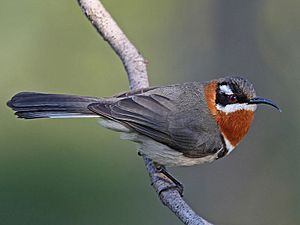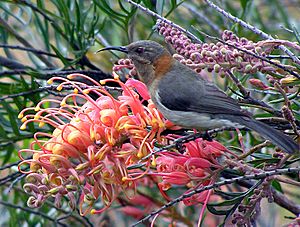Western spinebill facts for kids
Quick facts for kids Western spinebill |
|
|---|---|
 |
|
| Male | |
| Conservation status | |
| Scientific classification |
The western spinebill (Acanthorhynchus superciliosus) is a small honeyeater bird. It lives in the heath and woodland areas of south-western Australia. This bird is about 12 to 16 centimeters (5 to 6 inches) long. It weighs around 10 grams (0.35 ounces), which is very light!
The western spinebill has a black head and gray back and wings. It has a red band behind its neck. Another red band goes from its throat down to its chest. Its beak is long, thin, and curved. Like other honeyeaters, it mostly eats nectar from flowers. It also catches insects in the air or on plants.
Contents
What Does the Western Spinebill Look Like?
The western spinebill is a small bird with a long, curved bill. It usually measures from 12 to 16 cm (5 to 6 in) long. It weighs between 8 and 11 grams (0.28 to 0.39 oz). Male birds are a bit bigger than females.
Males and females look a little different. The male is dark olive-grey on top. He has a chestnut-colored patch on the back of his neck. His throat and chest are also chestnut, with a white and black band below. His belly is buff-colored. He has a white "eyebrow" and a black mask around his eyes. His outer tail feathers are white and he wiggles them when he flies.
The female is plainer. Her neck is a pale reddish-brown. Her throat and belly are pale grey or reddish-brown. She does not have the strong bands that the male has. Young birds look like plainer females, but their bill has a yellow base.
What Does it Sound Like?
The western spinebill makes a high, sharp, quick sound. It sounds like "kleet-kleet" or "kleat-kleat."
Where Does the Western Spinebill Live?
This bird lives only in the southwestern part of Western Australia. You can find it from north of Jurien Bay down to Israelite Bay. Inland, it lives in an area that includes Moora, Corrigin, and Lake Grace.
It is common in the low plants of heaths, coastal areas, woodlands, and forests. It also likes areas with many Banksia plants. Sometimes, these birds are kept in aviaries (large bird cages) in Western Australia.
What Does the Western Spinebill Eat?

Like other honeyeaters, the western spinebill mainly eats nectar from flowers. It spends more time eating nectar in the first 60 to 90 minutes of the day. This is more than it eats later in the day.
It especially loves the flowers of Banksia ilicifolia. It also feeds from other Banksia types, like B. menziesii and B. sessilis. These birds often feed on flowers lower down in the trees. This might be to avoid bigger, more aggressive honeyeaters.
The western spinebill is the only honeyeater that can get nectar from tube-shaped flowers. This is thanks to its long, curved bill. It also eats insects that it catches in the air or on plants.
How Does the Western Spinebill Reproduce?
Western spinebills usually breed from September to January. Sometimes, eggs are laid as early as August, and young birds can leave the nest as late as March.
The female builds a neat cup-shaped nest. She uses bark, grass, plant stems, and soft plant fluff. She holds it all together with spider webs. The nest is usually in a low bush or tree, about 1 to 5 meters (3 to 16 ft) off the ground.
The female lays 1 or 2 eggs. The eggs are about 17 x 13 mm (0.67 x 0.51 in) in size. They can be pinkish or bluish with spots of chestnut or purplish-brown. The female mostly sits on the eggs to keep them warm. The male helps only sometimes.
Both parents feed the baby birds. The young birds leave the nest after about 15 days. Both parents continue to feed them for some time after they fledge (leave the nest). Sometimes, a bird called a pallid cuckoo lays its eggs in the spinebill's nest. The spinebill parents then raise the cuckoo chick.
How Scientists Study the Western Spinebill
The western spinebill was first described by a scientist named John Gould in 1837. It is a "monotypic" species, which means there is only one type of this bird.
Scientists believe the western spinebill is very closely related to the eastern spinebill. They think both birds came from a common ancestor. This ancestor's population was split apart by changes in climate long ago. During a time when the land became like a desert, the ancestor birds moved to safe places. These places were in the southwest and southeast of Australia. Over time, they changed and became the two different spinebill species we see today.
Recent DNA studies show that the two spinebills belong to a special group. This group is like a "sister" group to all other honeyeaters.
The scientific name for the western spinebill is Acanthorhynchus superciliosus. The name Acanthorhynchus comes from Ancient Greek words. Akantha means 'spine' and rhunkhos means 'bill'. This refers to its spiny-looking bill. The second part of the name, superciliosus, is Latin for 'eyebrowed'. This describes the male's clear white eyebrow.
Long ago, early settlers learned that the Noongar people, who are the native people of southwestern Australia, called this bird "buljit."
|
See also
 In Spanish: Picoespina occidental para niños
In Spanish: Picoespina occidental para niños



